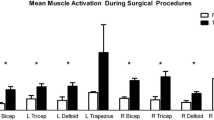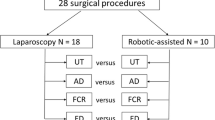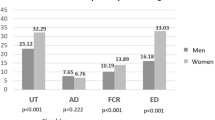Abstract
Introduction
Traditional laparoscopic surgery (TLS) has increasingly been associated with physical muscle strain for the operating surgeon. Robot-assisted laparoscopic surgery (RALS) may offer improved ergonomics. Ergonomics for the surgeon on these two platforms can be compared using surface electromyography (sEMG) to measure muscle activation, and the National Aeronautics and Space Administration Task Load Index (NTLX) survey to assess workload subjectively.
Methods
Subjects were recruited and divided into groups according to level of expertise in traditional laparoscopic (TLS) and robot-assisted laparoscopic surgery (RALS): novice, traditional laparoscopic surgeons (TL surgeons), robot-assisted laparoscopic surgeons (RAL surgeons). Each subject performed three fundamentals of laparoscopic surgery (FLS) tasks in randomized order while sEMG data were obtained from bilateral biceps, triceps, deltoid, and trapezius muscles. After completing all tasks, subjects completed the NTLX survey. sEMG data normalized to the maximum voluntary contraction of each muscle (MVC%), and NTLX data were compared with unpaired t tests and considered significant with a p ≤ 0.05.
Results
Muscle activation was higher during TLS compared to RALS in most muscle groups for novices except for the trapezius muscles. Muscle activation scores were also higher for TLS among the groups with more experience, but the differences were less significant. NTLX scores were higher for the TLS platform compared to the RALS platform for novices.
Discussion
TLS is associated with higher muscle activation in all muscle groups except for trapezius muscles, suggesting greater strain on the surgeon. Increased trapezius muscle activation on RALS has previously been documented and is likely due to the position of the eye piece. The differences seen in muscle activation diminish with increasing levels of expertise. Experience likely mitigates the ergonomic disadvantage of TLS. NTLX survey data suggest there are subjective benefits to RALS, namely in the perception of temporal demand. Further research to correlate NTLX data and sEMG measurements, and to investigate whether these metrics affect patient outcomes is warranted.


Similar content being viewed by others
Change history
22 November 2021
A Correction to this paper has been published: https://doi.org/10.1007/s00464-021-08879-z
References
Fonouni H, Mehrabi A, Golriz M, Zeier M, Muller-Stich BP, Schemmer P, Werner J (2014) Comparison of the laparoscopic versus open live donor nephrectomy: an overview of surgical complications and outcome. Langenbecks Arch Surg 399(5):543–551. https://doi.org/10.1007/s00423-014-1196-4
Nicholson ML, Elwell R, Kaushik M, Bagul A, Hosgood SA (2011) Health-related quality of life after living donor nephrectomy: a randomized controlled trial of laparoscopic versus open nephrectomy. Transplantation 91(4):457–461. https://doi.org/10.1097/TP.0b013e318204bdf7
Li MZ, Lian L, Xiao LB, Wu WH, He YL, Song XM (2012) Laparoscopic versus open adhesiolysis in patients with adhesive small bowel obstruction: a systematic review and meta-analysis. Am J Surg 204(5):779–786. https://doi.org/10.1016/j.amjsurg.2012.03.005
Lee G, Lee T, Dexter D, Godinez C, Meenaghan N, Catania R, Park A (2009) Ergonomic risk associated with assisting in minimally invasive surgery. Surg Endosc 23(1):182–188. https://doi.org/10.1007/s00464-008-0141-4
Youssef Y, Lee G, Godinez C, Sutton E, Klein RV, George IM, Seagull FJ, Park A (2011) Laparoscopic cholecystectomy poses physical injury risk to surgeons: analysis of hand technique and standing position. Surg Endosc 25(7):2168–2174. https://doi.org/10.1007/s00464-010-1517-9
Park A, Lee G, Seagull FJ, Meenaghan N, Dexter D (2010) Patients benefit while surgeons suffer: an impending epidemic. J Am Coll Surg 210(3):306–313. https://doi.org/10.1016/j.jamcollsurg.2009.10.017
Payne TN, Dauterive FR (2008) A comparison of total laparoscopic hysterectomy to robotically assisted hysterectomy: surgical outcomes in a community practice. J Minim Invasive Gynecol 15(3):286–291. https://doi.org/10.1016/j.jmig.2008.01.008
Zihni AM, Cavallo JA, Ray S, Ohu I, Cho S, Awad MM (2016) Ergonomic analysis of primary and assistant surgical roles. J Surg Res 203(2):301–305. https://doi.org/10.1016/j.jss.2016.03.058
Lee GI, Lee MR, Clanton T, Sutton E, Park AE, Marohn MR (2014) Comparative assessment of physical and cognitive ergonomics associated with robotic and traditional laparoscopic surgeries. Surg Endosc 28(2):456–465. https://doi.org/10.1007/s00464-013-3213-z
Lee G, Lee T, Dexter D, Klein R, Park A (2007) Methodological infrastructure in surgical ergonomics: a review of tasks, models, and measurement systems. Surg Innov 14(3):153–167. https://doi.org/10.1177/1553350607307956
Zihni AM, Ohu I, Cavallo JA, Cho S, Awad MM (2014) Ergonomic analysis of robot-assisted and traditional laparoscopic procedures. Surg Endosc 28(12):3379–3384. https://doi.org/10.1007/s00464-014-3604-9
Hart SG (2006) Nasa-Task Load Index (NASA-TLX); 20 years later. Proc Hum Factors Ergonomics Soc Ann Meet 50(9):904–908. https://doi.org/10.1177/154193120605000909
Hart SG, Lowell E (1988) Development of NASA-TLX (Task Load Index): results of empirical and theoretical research. In: Advances in psychology, vol 52, pp 139–183
Zihni AM, Ohu I, Cavallo JA, Ousley J, Cho S, Awad MM (2014) FLS tasks can be used as an ergonomic discriminator between laparoscopic and robotic surgery. Surg Endosc 28(8):2459–2465. https://doi.org/10.1007/s00464-014-3497-7
Wang R, Liang Z, Zihni AM, Ray S, Awad MM (2017) Which causes more ergonomic stress: laparoscopic or open surgery? Surg Endosc 31(8):3286–3290. https://doi.org/10.1007/s00464-016-5360-5
Acknowledgements
The authors thank Gyusung Lee, PhD of the American College of Surgeons (Chicago, IL) for his valuable advice. This study was supported by research grants from the Society of Gastrointestinal and Endoscopic Surgeons (SAGES) and Intuitive Surgical, Inc (Sunnyvale, CA).
Author information
Authors and Affiliations
Corresponding author
Ethics declarations
Disclosures
Dr. Zihni received research grant funding for unrelated studies from the National Institutes of Health. Dr. Cavallo has received research grant funding for unrelated studies from the National Institutes of Health, the Society of American Gastrointestinal and Endoscopic Surgeons (SAGES), and the American Hernia Society in collaboration with Davol® Incorporated; and has served as a one-time consultant for Guidepoint Global® Incorporated. Dr. Cho has received research grant funding from the Society of Gastrointestinal and Endoscopic Surgeons (SAGES) and Intuitive, Surgical Inc. (Sunnyvale, CA) Dr. Awad has received research grant funding from the Society of Gastrointestinal and Endoscopic Surgeons (SAGES) and Intuitive, Surgical Inc. (Sunnyvale, CA) Dr. Ohu has received unrelated research grants from the American Heart Association. Dr. Zárate Rodriguez has no conflicts of interest or financial ties to disclose.
Rights and permissions
About this article
Cite this article
Zárate Rodriguez, J.G., Zihni, A.M., Ohu, I. et al. Ergonomic analysis of laparoscopic and robotic surgical task performance at various experience levels. Surg Endosc 33, 1938–1943 (2019). https://doi.org/10.1007/s00464-018-6478-4
Received:
Accepted:
Published:
Issue Date:
DOI: https://doi.org/10.1007/s00464-018-6478-4




